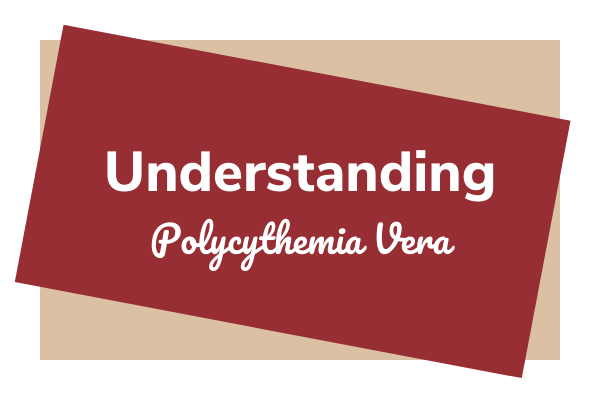Understanding Polycythemia Vera
Polycythemia vera, or PV, is one of a related group of blood cancers known as myeloproliferative neoplasms (MPNs). In people with PV, too many red blood cells are made in the bone marrow, and in many cases, the numbers of white blood cells and platelets are also elevated.
With careful medical supervision, PV can usually be managed effectively for many years. For some people with PV, however, the PV may progress to a more aggressive blood disease, such as myelofibrosis, acute myeloid leukemia, or myelodysplastic syndromes.
How Does PV Develop?
PV develops when the DNA (genetic material) of a developing stem cell in the bone marrow is damaged. This is called an acquired mutation. Stem cells form blood cells (white cells, red cells, and platelets).
The mutated cell leads to uncontrolled blood cell production, especially red cells. In many cases, the numbers of white blood cells and platelets are also elevated. With extra blood cells in the bloodstream, abnormal clots and bleeding are more likely to occur. This can increase the risk of heart attack, stroke (a clot that blocks blood flow to part of the brain, which can damage brain tissue), pulmonary embolism (blockage of an artery in the lungs), and accumulation of extra blood cells in the spleen, causing the spleen to swell.
Polycythemia vera is a chronic disease: It’s not curable, but it can usually be managed effectively for very long periods.
Signs & Symptoms of PV
Polycythemia vera develops slowly, and it may not cause symptoms for many years. The condition is often diagnosed during a routine blood test before severe symptoms occur. Symptoms may include
- Itchy skin, called pruritus, especially after warm baths or showers
- Headaches
- Excessive sweating
- Blurred vision, double vision, or seeing dark or blind spots that come and go
- Ringing in the ears
- Fatigue
- Shortness of breath
- Weakness
- Dizziness
- Excessive bleeding or bruising
- Reddened skin
- Numbness, tingling, or burning sensation in the feet
- Feeling of fullness or bloating in the left upper abdomen due to an enlarged spleen
- Weight loss for no known reason
- Painful inflammation in the joints caused by gout
What You Should Do If You’ve Been Diagnosed with PV
- Talk with your doctor about your diagnostic tests and what the results mean.
- Talk with your doctor about all your treatment options, side effects, and the results you can expect from treatment.
- Ask your doctor whether a clinical trial is a good treatment option for you.
Diagnosing Polycythemia Vera
While a person may have certain signs and symptoms of PV, laboratory tests are needed to confirm the diagnosis. Generally, a doctor will consider other conditions first.
Sometimes a condition called secondary polycythemia is causing the increase in red blood cells, but, unlike PV, it does not begin in the bone marrow and is not a cancer. High red blood cell counts caused by secondary polycythemia are a reaction to another problem such as
- High altitude
- Disease that leads to low oxygenation of the blood
- Kidney or liver tumor that secretes the hormone erythropoietin
- Inherited disease
Secondary polycythemia is managed primarily by treating the underlying condition causing the disorder. A person with secondary polycythemia should have a return to normal red blood cell counts once the primary problem is successfully treated.
Evaluation of an individual with suspected PV should start with a detailed medical history and a physical examination by a hematologist-oncologist. A hematologist-oncologist is a doctor who specializes in treating people with blood cancers.
PV Management & Treatment
Polycythemia vera is a chronic disease: It’s not curable, but it can usually be managed effectively for very long periods. The goal of therapy is to reduce the risk of thrombosis and to ease symptoms by lowering the number of extra blood cells.
Every person’s medical situation is different and should be evaluated individually by a hematologist-oncologist. As you develop a treatment plan with your doctor, it is important to discuss
- The results you can expect from treatment
- Potential side effects
- All treatment options, including treatments being studied in clinical trials
You may find it helpful to bring a loved one with you to your doctor’s visits for support and to take notes and ask follow-up questions. It’s a good idea to prepare questions you’d like to ask when you visit your doctor. You can also record your conversations with your doctor and listen more closely when you get home.
Medical supervision of individuals with PV is important to prevent or treat complications. With careful medical supervision and therapy, PV can usually be managed effectively for a long time.
Excerpted with permission from The Leukemia & Lymphoma Society’s book Myeloproliferative Neoplasms. For free information on blood cancers, contact The Leukemia & Lymphoma Society Information Specialists at (800) 955-4572 or visit LLS.org.
This article was published in Coping® with Cancer magazine, September/October 2021.


